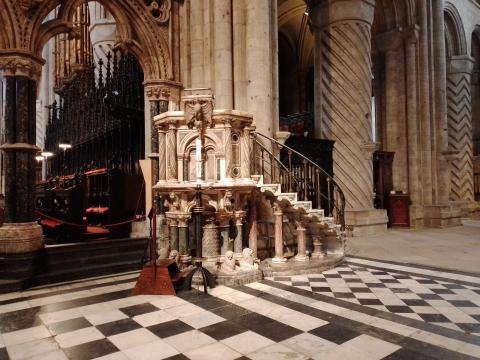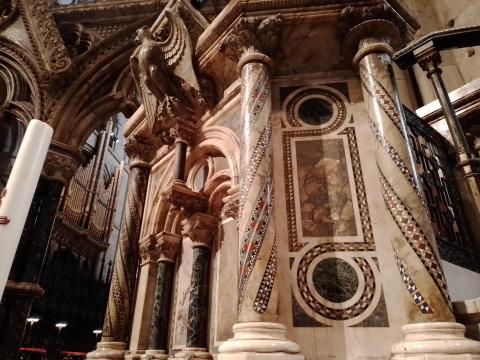Durham's Pulpit

The pulpit of Durham Cathedral is wonderfully decorated and intricrate, as one might expect for so august a setting and so visually stunning a backdrop. Unlike the wider fabric, it is only Victorian (1874), but built to a mediaeval, Romanesque design. Sadly, but typically, it is off-centre, as though the preaching of God’s word is sidelined before the affairs of the chancel and high altar.
I wonder how often God’s word was truly preached from here. Durham was once burdened with the infamous David Jenkins as its bishop in 1984. Why those in leadership would see fit to appoint a man of heterodox theology, one cannot say. I suspect that his criticisms of Margaret Thatcher made his appointment appear desirable, especially in the run up the Church of England’s 1985 Faith in the City report, which was critical of the Conservative government’s economic and social record. Although Jenkins has sometimes been misquoted, he was not a subscriber to traditional, credal and Biblical Christianity. Such a man has the right to believe what he wishes, of course, but had no right to belong to a mainstream Christian church, much less become one of its most prominent leaders.
Anglican cathedrals are controlled by their respective Deans rather than bishops, so the number of times he entered this grand cathedral pulpit to spout his nonsense is probably rather less than we imagine. Yet here is a gilded platform, an elaborate and beautiful podium from which ugly, soul-destroying and hell-stinking doubts and denials were published and propagated. One might place faeces in a golden vessel encrusted with gems, but the contents will remain odious; one may store poison in a sparkling, crystal bottle, but it will still kill you if quaffed. One may put a mitre on Satan’s head and a chasuble about his shoulders, but he will still escort you to the furnace given half a chance.

- Log in to post comments


 Sunday Worship 10.45am & 6.00pm
Sunday Worship 10.45am & 6.00pm